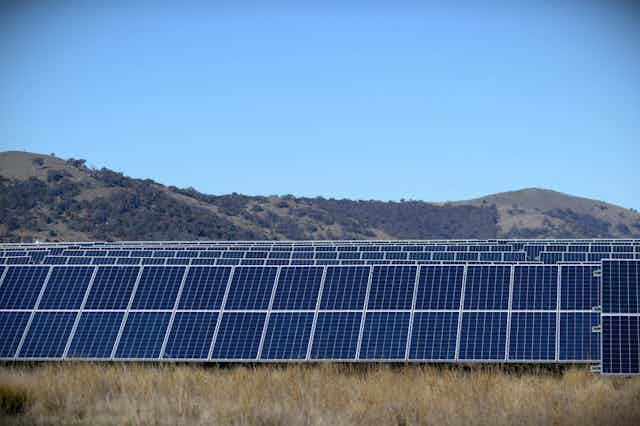The Australian Greens this weekend announced a target of 90% renewable electricity by 2030 – pledging to go further than Labor, which has already backed a target of 50%. How hard is it to reach these targets?
The Abbott government made plain its dislike of renewable energy by reducing the renewable electricity target (RET) for 2020 to 33 terawatt hours (TWh) of new renewable electricity.
Under this target, about 24% of electricity will come from renewable sources in 2020, comprising existing renewables (mostly hydro-electricity with some biomass) and new renewables (mostly wind energy and photovoltaic (PV) solar energy). It’s straightforward to calculate the annual additions (gigawatts, GW) of wind and PV required to hit a 50% or 90% RET in 2030.
First, let’s assume that Australia’s electricity demand remains static at about 200 TWh per year. Demand has been falling or static since 2008, caused by improving energy efficiency of buildings and appliances, reduced demand from heavy industry, and increased price of retail electricity, together with the rise and rise of behind-the-meter rooftop PV systems.
Second, let’s assume that wind and PV will each constitute half of new generation. These two technologies constitute virtually all new generation capacity in Australia, and together are being installed at a greater rate worldwide than the combined amount of new fossil and nuclear capacity. They are set to dominate the world’s energy future because they are effectively unconstrained by energy resource, raw materials, greenhouse gas emissions, local pollution, security concerns, or price.
Third, let’s assume that the “capacity factors” of these technologies remain at their current typical values of 25% for tracking PV and 40% for wind. (Capacity factor is the effective proportion of time that an electricity generator operates at nominal full load.)
Under these assumptions, we would need about 3 GW of new PV and 2 GW of new wind power capacity each year to reach a 90% renewables target by 2030. This is about 5% of the current worldwide installation rates, which themselves are increasing at 10-20% per year.
The corresponding figures for Labor’s target of 50% by 2030 are 1.2 GW of PV and 0.8 GW of wind per year.
An achievable prospect
Labor’s target is a straightforward prospect. In years gone by, Australia has installed this much PV and wind in a year, and can readily do so again. It is not much more than the installation rate needed to meet the 2020 RET.
The Greens’ target, meanwhile, is about 2.5 times more challenging than Labor’s, but still readily achievable. The Australian Capital Territory and South Australia have shown the way by adding new renewable electricity capacity equivalent to 90% and 40% respectively of their annual electricity consumption – mostly over a period of about 5 years. There are no practical constraints in terms of land because of Australia’s vast solar and wind resources.
Australia’s electricity system is becoming increasingly renewable. From the greenhouse point of view, natural gas should be pushed out of the market in favour of electrically driven heat pumps for the supply of water heating and space heating and cooling. This may happen anyway for economic reasons.
Similarly, conversion of land transport to electric vehicles will eliminate another substantial source of greenhouse gas emissions. As heat pumps and electric cars are about three times more efficient than gas heating and petrol cars, only a few years of extra building of PV and wind would be required to meet the extra electricity demand. A combination of existing hydroelectric power stations, new off-river pumped hydro energy storage, and battery storage, allows stabilisation of a 100% renewable electricity system.
The most straightforward mechanism to achieve a 50% or 90% renewables target by 2030 is simply to extend and uplift the existing 2020 RET. However, recent experience shows how easily governments can create investment risk by seeking to reduce the target, and how this can inhibit investment. Various other mechanisms can be introduced to confer investment certainty, including reverse auctions to lock in prices for 20 years (as pioneered in Australia by the ACT Government).
How much will it cost?
This question is difficult to answer. At present, wind power costs about 8 cents per kilowatt hour (kWh), and PV about 12 cents per kWh in Australia when constructed on a moderate scale (less than a gigawatt per year). PV in particular is falling rapidly in price, and both are likely to reach 6-8 cents per kWh by 2020 when constructed at a scale greater than a gigawatt per year.
The overall wholesale price of electricity is currently 3-4 cents per kWh, but this is mostly from old fossil fuel generators for which the capital cost has already been repaid, and for which there is no longer a carbon price. Energy from new-build gas or coal generators would cost 8-12 cents per kWh – so it could potentially end up being more expensive than new renewables.
Most of Australia’s existing coal power stations will be retired over the next two decades in the ordinary course of business, perhaps replaced by cheaper PV and wind. In this sense, the conversion to renewables would cost nothing extra.
One way of measuring whether a rapid phase-out of fossil fuel generation will affect the economy is to observe that the carbon price during 2012-14 was 2.5 cents per kWh, and that this constitutes most of the difference in cost between old (sunk-cost) fossil fuel generators and the 2020 cost of electricity from PV and wind. That carbon price did not noticeably affect the economy.

